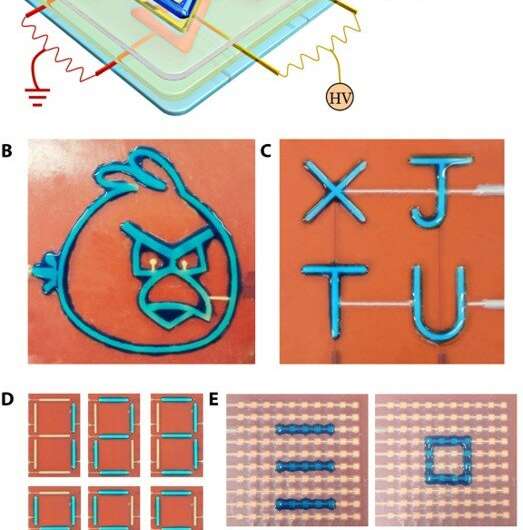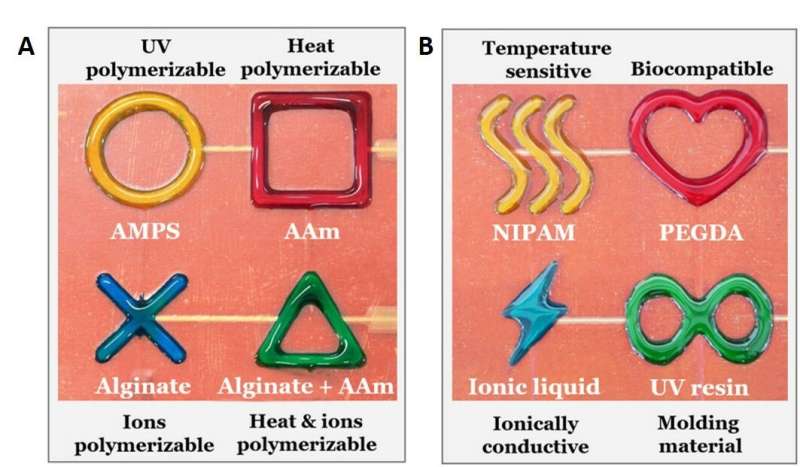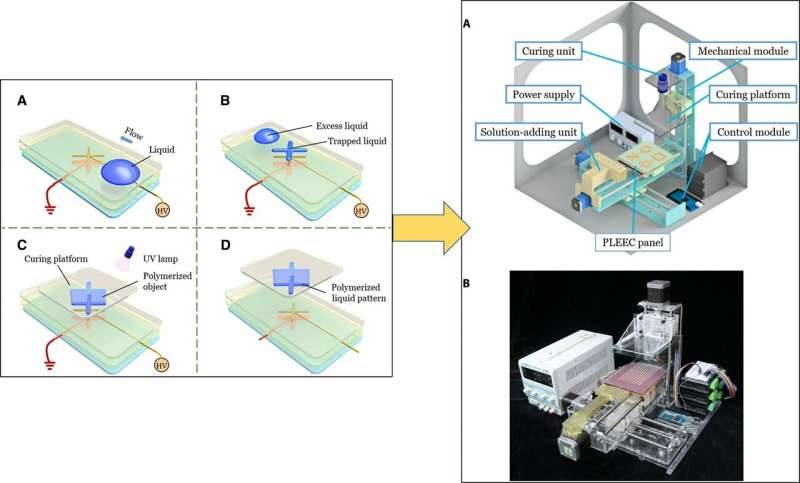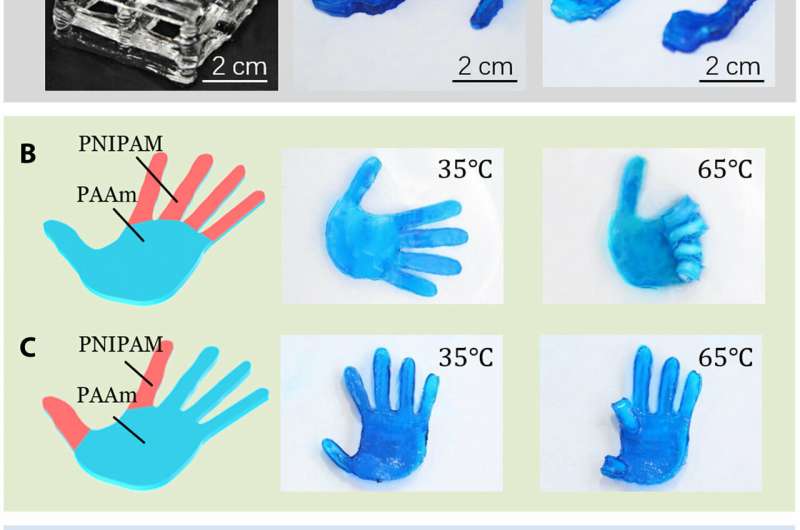April 1, 2019 feature
Hydrogel 3-D printing and patterning liquids with the capacitor edge effect (PLEEC)

Hydrogels are three-dimensional (3-D) polymer networks that can retain large quantities of water in their swollen states for wide applications in bioengineering and materials sciences. Advanced hydrogel fabrication techniques are in development to meet user-specified requirements with substantial constraints placed on the physical and chemical properties of hydrogel precursors and printed structures. In a recent study, Jikun Wang and co-workers at the State Key Lab for Strength and Vibration of Mechanical Structures, Department of Engineering Mechanics, in China, proposed a new method of patterning liquids with the capacitor edge effect (PLEEC). The results are now published in Science Advances.
Using the new patterning method, Wang et al. accomplished a resolution of 100 µm, while also allowing them to establish a complete 3-D printing system that combined patterning and stacking processes. The technique can be applied to a wide variety of hydrogels to overcome existing limits. In the work, the scientists demonstrated printed hydrogel structures including a hydrogel scaffold, a thermoresponsive hydrogel composite and an ionic high-integrity hydrogel display device. The proposed technique can offer rapid prototyping hydrogel devices with multiple compositions and complex geometries.
Additive manufacture or 3-D printing is an effective tool to engineer highly structured, interconnected and porous architectures compared to conventional methods of casting, photomasking and electrospinning. Researchers have previously used 3-D printing to create highly porous hydrogel scaffolds for cell cultures, as biomimetic microchips to study disease, build artificial heterogeneous tissues in regenerative medicine and as biocompatible organs with high geometric precision. 3-D hydrogels are also used to build conductive composites for soft robotics. In particular, computer-aided design (CAD) in 3-D printing is suited to build highly programmed and user-specified hydrogel structures for applications in tissue engineering.
Previously established methods for hydrogel printing conventionally include digital projection lithography (DLP), stereolithography (SLA) and direct ink writing (DIW). However, such methods are limited to patterning with photopolymerizable hydrogel precursors only. Similarly, in the DIW-printing method, hydrogel precursors are water-like and difficult to deposit unless their viscosity is increased with nanoclays, affecting the processing technique. Electric fields are another technique that have been used to control liquids via electrowetting, dielectrophoresis and lithography induced self-assembly. Although the techniques can control single droplets between electrodes for applications in cell culture, patterned wettability, microfluidics and patterning electronics, electric fields can only manipulate a single droplet at a time. As a result, the technique lacks massive-scale control of liquid droplets, with difficulty of their use in 3-D printing.

In the present work, Wang et al. proposed PLEEC (patterning liquids with the capacitor edge effect) to pattern liquids with different physical and chemical properties. The method can be applied to a variety of crosslinking mechanisms among multiple materials. The scientists used a capacitor that was asymmetric in design to allow the construction of a real 3-D object than mere 2-D patterns built within two electrodes. Based on the new method, Wang et al. built the 3-D printing system, to provide proof-of-concept printed hydrogel structures including a hydrogel scaffold, hydrogel composite and hydrogel ionic devices in the study.
The PLEEC panel proposed in the study contained five layers, where the top layer (Teflon film) acted as a hydrophobic, insulating cover to separate the liquid from the upper electrode. When the scientists applied an electric field, the edge effect generated an electrostatic force that trapped the liquid atop the hydrophobic layer. Using the principle, the scientists designed liquid patterns with different shapes and sizes. For instance, the trapped blue ink formed patterns of an Angry Bird and the letters XJTU. In addition, the scientists used an array of line pixels to control and trap liquid independently. Furthermore, in an array of 10 x 10 pixels, the scientists were able to form a variety of liquid patterns such as lines, squares and musical notes. With further developed circuit control technology, additional complex liquid patterns could be designed and controlled using PLEEC.

As a proof-of-concept the scientists trapped four hydrogel precursors using an electric field, to form diverse structures. For example, Wang et al. trapped 2-acrylamido-2-methylpropanesulfonic acid (AMPS) solution to form a yellow circle, which then polymerized into the PAMPS hydrogel on exposure to UV light. They then similarly trapped the acrylamide solution (AAm) to form a red square, which then polymerized into the PAAm hydrogel by heat. The two hydrogel precursors (AMPS and AAm) were water-like and difficult to control via any other technique to begin with. Wang et al. also formed a blue cross using the alginate solution, which then polymerized into a brittle alginate hydrogel via ion exchange, followed by a green triangle formed using the alginate/AAm solution, which polymerized into an alginate/AAm tough hydrogel by heat and ion exchange.
Apart from hydrogel precursors, Wang et al. were able to trap functional materials similarly using the electric field to form yellow wavy lines using N-isopropyl acrylamide solution, polymerized into temperature-sensitive PNIPAM hydrogels. They then formed a red heart using a polyethylene glycol diacrylate solution (PEGDA) widely used in bioengineering applications, followed by the blue flash formed with trapped ionic liquid that was ionically conductive and non-volatile suited for stretchable ionic conductors. A green infinity loop shape resulted from trapped photosensitive resin widely used in 3-D printing. The scientists thus demonstrated how PLEEC could trap a wide variety of hydrogel solutions for large-scale liquid manipulation and hydrogel 3-D printing. The electric field was able to trap a line of water at 100 µm resolution, very close to that observed with DLP and SLA.

Wang et al. polymerized the 2-D hydrogel precursor patterns and stacked them layer-by-layer to form a 3-D structure thereafter. In the experimental setup, the liquids flowed across the designed electrodes to form liquid patterns trapped by the electric field. A transparent curing platform then approached the liquid pattern to polymerize it in the plane of printing using UV light. The scientists determined the printing speed of the PLEEC method by deducing the time of liquid patterning, which was in the order of 101s and the time of polymerization in the order of 102 s, comparable to the DLP technique.
Based on the PLEEC process, Wang et al. designed a complete PLEEC 3-D printing system with seven parts: a mechanical module, PLEEC panel, solution-adding unit, a curing platform, curing unit, power supply and a control module. The scientists used the solution adding holes in the setup to squeeze the hydrogel solutions onto the PLEEC panel and a UV lamp in the curing unit to complete the in-house printing system. They regulated the power supply using the control unit to provide a low voltage for mechanical movement of the module and higher voltage—as high as 3000 V at 1 kHz to the PLEEC panel. In turn, Wang et al. operated the control module using a central computer to send instructions to all units.
Using the in-house printing system, the scientists then designed a hydrogel composite containing different percentages of PAAm and PNIPAM solutions, which they polymerized in the shape of a human hand, followed by triggered thermoresponsive behavior to form the finger gestures of "GOOD" and "OK." The scientists also used the same experimental setup to engineer stretchable LED belts and soft display devices, where each LED in the system could be independently lit.

In this way, Wang et al. proposed a new PLEEC panel design to generate complex liquid patterns and transferred the concept to build a 3-D printing system as demonstrated. The technology has several advantages and offers significant versatility compared to the existing methods of hydrogel 3-D printing. As a proof-of-concept, they used a wide variety of hydrogels with varying physical or chemical properties in the system and showed the possibility of using materials with varying viscosity, either bonded physically or chemically to construct structures of interest. Multiple hydrogel materials could also be easily patterned to form a variety of soft and hard, to active and passive hydrogel composites. They assembled the ionically conductive hydrogels in a single-step curing process for ease, demonstrating excellent integrity and bonding properties.
The researchers aim to improve the precision of the technique in the future and optimize the 3-D printing PLEEC setup to streamline rapid prototyping. The optimized method will enable dynamic applications in tissue engineering such as artificial tissues, soft metamaterials in materials science, soft electronics and soft robotics.
More information: Jikun Wang et al. Hydrogel 3D printing with the capacitor edge effect, Science Advances (2019). DOI: 10.1126/sciadv.aau8769
David J. Beebe et al. Functional hydrogel structures for autonomous flow control inside microfluidic channels, Nature (2002). DOI: 10.1038/35007047
A. Sidorenko et al. Reversible Switching of Hydrogel-Actuated Nanostructures into Complex Micropatterns, Science (2007). DOI: 10.1126/science.1135516
Journal information: Science Advances , Nature , Science
© 2019 Science X Network




















